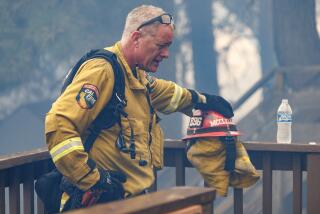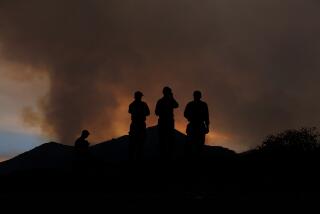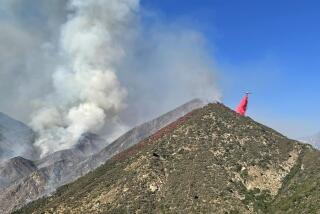Forest Service ends ban on night flights to battle fires
In a policy shift brought on by scrutiny of the disastrous 2009 Station fire, the U.S. Forest Service will begin nighttime helicopter missions to battle blazes in the Angeles National Forest and other federal lands in Southern California.
The Forest Service said Thursday it has scrapped a ban on night flying to fight wildfires, a prohibition imposed about 30 years ago for safety and cost reasons, and plans to start flights after dark next summer, once crews have been trained and equipped.
“We have made this important decision very carefully,” Forest Service Chief Tom Tidwell said in a statement. “We have studied night operations from every angle — risk management, business and operations — and we have concluded we can conduct night operations safely and effectively.”
The reversal in tactics grew out of Times reports and subsequent congressional inquiries into the Forest Service’s initial response to the Station fire, the largest in Los Angeles County history. Two firefighters died in the flames.
Citing records and interviews, The Times reported that the Forest Service misjudged the threat posed by the fire the first day, rolled back its attack that night and did not fill a commander’s orders for a heavy air assault early the next morning. Experts have said a run of helicopters after dark might have helped firefighters contain the blaze when it was still a few acres.
Rep. Adam B. Schiff(D-Burbank), Rep. Howard “Buck” McKeon (R-Santa Clarita), Sen. Dianne Feinstein (D-Calif.) and others later called for a probe by the Government Accountability Office, the investigative arm of Congress. Schiff and Feinstein also pressed for a review of the night-flight ban.
In a report last December, the GAO concluded that the Forest Service both failed to use all potentially available aircraft early in the blaze and needed to develop a strategy for when night missions should be flown.
“We will never know with certainty if night flying could have extinguished the Station fire in those critical first hours, but I’m glad we will have a better chance in the future,” Schiff, the most vocal advocate of after-dark missions, said in a statement Thursday.
“With temperatures hitting triple digits this summer, it’s hard for California residents not to worry that another fire could sweep through and devastate our region once again,” he said. “This step today by the Forest Service [will] provide an important new line of defense.”
Feinstein said in a statement that night flights “can bolster firefighting efforts because temperatures are cooler, humidity is higher and Santa Ana winds die down.”
Los Angeles city and county fire departments, among other agencies, routinely use aircraft to douse flames at night. After the Times reports on the Station fire, the Forest Service moved to work more closely with the county, including on night flights by county choppers in the Angeles National Forest.
The Forest Service said Thursday that it will launch its night missions with a specially equipped helicopter to supplement other air operations in and around the Angeles, Cleveland and San Bernardino national forests and the southern half of the Los Padres National Forest.
Eventually, the $2-million program could be broadened to provide air medical transport for firefighters and other support functions, the agency said.
Tom Harbour, director of fire and aviation for the Forest Service, said the agency could ultimately assemble a fleet of helicopters devoted exclusively to night firefighting. “We’ll get started with one,” he said. “If we’re successful, we’ll add more.”
The Station fire blackened 160,000 acres in the Angeles National Forest and destroyed more than 200 structures. On the fifth day, two Los Angeles County firefighters died trying to defend their mountain camp.
The suspected arson fire burned for some seven weeks, and its scars still mar huge swaths of the forest. The arson case remains unsolved.
Former and current Angeles National Forest residents welcomed the about-face on night flying, but not without revisiting their frustration over the management of the Station fire.
“It’s about time,” said Elva Lewis, who lost her home and roadside cafe to the conflagration. Lewis and her family had lived and worked in the forest for 39 years. She said she has been unable to rebuild.
If Forest Service officials had deployed helicopters the first night of the blaze, Lewis said, “they could have avoided the whole fire.”
Bronwen Aker, who launched a website, angelesrising.org, for residents recovering from the fire, said Thursday’s news was “too little too late, but hopefully it will help avoid similar catastrophes in the future.”
The fire had been all but knocked down on Day 1, Aug. 26, after a sustained pounding by helicopters and planes that ended at nightfall. The flames gathered strength in the darkness and then outran ground crews after choppers and air tankers ordered for 7 a.m. did not reach the scene until about two hours later, according to records and interviews.
Forest Service officials have defended their handling of the fire, saying the agency staged the morning attack as soon as they could muster federal tankers with rested pilots.
However, Forest Service records showed that the aircraft order was not formally processed.
The GAO determined that federal planes probably could not have reached the fire by 7 a.m., but the Forest Service could have requested state air tankers that were available.
More to Read
Sign up for Essential California
The most important California stories and recommendations in your inbox every morning.
You may occasionally receive promotional content from the Los Angeles Times.











